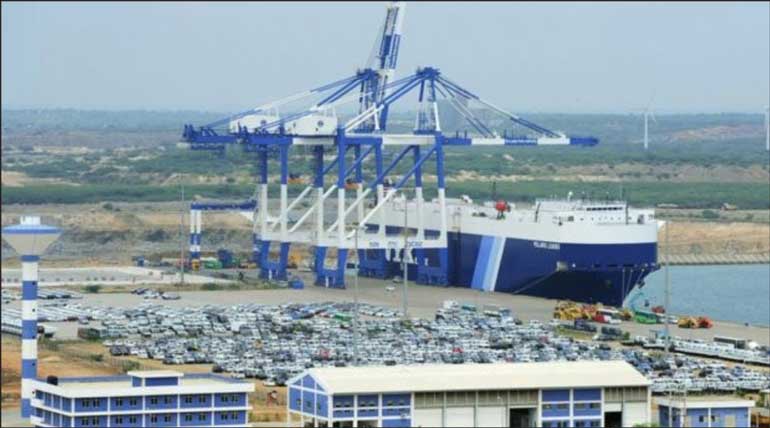Thursday Apr 24, 2025
Thursday Apr 24, 2025
Saturday, 12 June 2021 00:10 - - {{hitsCtrl.values.hits}}

A war-ravaged and debt-burdened Sri Lanka, right on the doorstep of China’s regional rival, India, offered a golden opportunity that was too good to miss. From the point of view of Rajapaksa’s Sri Lanka, China’s OBOR with its latest subway, China-Pakistan-Sri Lanka-Economic Corridor became Colombo’s highway to Beijing. Even a regime change in 2015 by the West-oriented UNP could not change that direction. In fact, the 99-year lease of Hambantota Harbour signed by the new regime reinforced China’s long-term foothold in Sri Lanka
 Is Indian Ocean Indian?
Is Indian Ocean Indian?
Post-war Sri Lanka has turned into a contestable terrain for a new Great Game played chiefly between two regional powers, India and China with their respective allies.
Although India’s presumption of control over the Indian Ocean remained uncontested once the former colonial masters started leaving the region one by one, and when Indian historians and political strategists like K.M. Panikkar warned Independent India of economic and security perils of surrendering control over Indian Ocean, the end of the Cold War in 1980s, rise of a new imperial order cemented by economic globalisation, and challenge to that order by China after Mao dramatically transformed the global significance of that ocean.
The Indian Ocean touches the shores of 40 independent nation states that house 40% of the world’s population. Two-thirds of the world’s oil shipment, one-third of its bulk cargo and one-half of container traffic travels through this ocean. In short, 80% of global seaborne trade passes through this arterial waterway. What is even more crucial in the context of present discussion is that China’s export of goods reaches the Persian Gulf, East Africa, Western Europe and North America by set sailing towards the Cape of Good Hope via the Indian Ocean route. Hence, freedom of navigation through the Indian Ocean or at least some control over that volume of water is extremely vital for the global aspirations of this awakened giant.
Two centuries ago, it was Napoleon Bonaparte who said this with one hundred percent accuracy: “China is a sleeping giant, let her sleep, for when she wakes, she will shake the world”. She is shaking now. Indian Ocean is no more Indian just as the Persian Gulf is no more Persian.
China in Sri Lanka
Apart from a 14th century brief foray into Sri Lanka’s Kotte Kingdom by the Chinese Eunuch Muslim Admiral, Zheng He, the signing of the Rubber-Rice Pact in 1952, opening of formal diplomatic relations between the two countries in 1957, China’s gift of the Bandaranaike Memorial International Conference Hall in 1973, and the visit to Beijing by SL President Chandrika Bandaranaike Kumaratunga (CBK) at the invitation of her Chinese counterpart Jiang Zemin in 1996, China’s presence in Sri Lanka was nothing more than ordinary.
It was the civil war that really tied together the two nations into what now looks like an inseparable economic, diplomatic and even security relationship. Sri Lanka’s former president CBK expressed publicly that the country has become almost a colony of China. Certain developments as will be shown below would vouch for her contention.
Delhi’s dilemma and China’s opportunity
India’s pretended neutrality but covert support to Rajapaksa regime’s war efforts, and Delhi’s dilemma over aiding post-war reconstruction efforts by the same regime should bear some responsibility for pushing Sri Lanka more and more into the fold of China. US’s and her Western allies’ withdrawal of support to the regime over its condemnable record of human rights violations and tardiness in effecting post-war reconciliation made that push stronger and speedier.
Shivshankar Menon, India’s former Ambassador to Sri Lanka (1997-2000), candidly explains Delhi’s predicament as, “an impossible choice between reasons of state and humanitarian instincts, between idealism and self-interest, between intervention and allowing a war to run its course. As a democracy, India chose to find a middle way between them, to try to satisfy both, in the event not fully satisfying either.” (Shivshankar Menon, Choices: Inside the Making of India’s Foreign Policy, Washington DC, Brooking Institution Press, 2016, p. 103).
He also states that had “India … stood aside … defending the killers of an Indian prime minister, we would have effectively written ourselves out of Sri Lanka for the next decade or more, sacrificing our maritime and other interests in Sri Lanka and abdicating a geopolitically strategic neighbour to other powers (p. 96). However, when one looks at developments in the island since Menon published his analysis his fears seem to have almost come true.
Delhi’s hard choice and the West’s reluctance to help the Rajapaksa Government left a huge gap which came as manna from heaven for China to capitalise. An awakened China with aspirations for economic dominance globally and to counter the unipolar world order embarked on her string of pearls strategy with the construction of her One-Belt-One-Road (OBOR) new maritime silk road, through the Indian Ocean. Acquiring at least semi-permanent halting stations along that route would clear the way for her final objective.
A war-ravaged and debt-burdened Sri Lanka, right on the doorstep of China’s regional rival, India, offered a golden opportunity that was too good to miss. From the point of view of Rajapaksa’s Sri Lanka, China’s OBOR with its latest subway, China-Pakistan-Sri Lanka-Economic Corridor became Colombo’s highway to Beijing. Even a regime change in 2015 by the West-oriented UNP could not change that direction. In fact, the 99-year lease of Hambantota Harbour signed by the new regime reinforced China’s long-term foothold in Sri Lanka.
China’s consolidation and Delhi’s retraction
With the return of the Rajapaksa regime in 2019, Delhi’s relations with Colombo became even more precarious. Once again, the Tamil issue in the shape of the 13th Amendment, a legacy of the slain Prime Minister Rajiv Gandhi, has become a sore point. When President Gotabaya Rajapaksa visited Delhi soon after he was elected, Prime Minister Narendra Modi insisted that Sri Lanka implements that amendment in return for economic assistance. Although the visitor agreed to do so in Delhi, he reneged on his word after returning to Colombo, which was virtually a slap on Modi’s face.
As if to redress the situation, the Rajapaksa regime signed a deal with India and Japan to build and operate the East Container Terminal in Colombo Harbour. That deal was forced to be withdrawn by Sri Lanka unilaterally due to non-stop protests from trade unions and Buddhist monks, apparently instigated by China. Even before reneging on that deal the Rajapaksa cabinet provocatively approved to allow Sinosoar-Etechwin Joint Venture in China to install hybrid renewable energy systems in three of Sri Lanka’s small islands, Nainativu, Neduntivu and Analaitivu – all three situated in Palk Strait and less than 50 km away from Tamil Nadu. India raised its concerns without any response from Sri Lanka.
The completion of the celebrated Colombo Port City, built entirely at China’s expense of $ 15 billion, on a 269-hectare reclaimed land, is the crowning achievement of China’s consolidation of her foothold in Sri Lanka. This Port City has been technically handed over to an independent Commission whose members have been appointed by President GR. A Bill to that effect was hastily presented in the rubber stamp parliament and was rushed through in spite of serious criticisms from the opposition.
This Port City has been advertised to the world, including India, as a one-stop destination for foreign and local investors and is described as marking a turning point in the country’s economic development. State Minister Cabraal invited investors to capitalise on the ‘awesomeness’ of Sri Lanka. (He must have actually meant the Port City’s awesomeness, because there is a lot of awfulness outside that fantasyland engulfed by the pandemic, which would distract global fortune hunters). Yet, how much of control will China exert over this financial and entertainment megalopolis and how much of the revenue earned there would trickle down to historic Sri Lanka, are questions to which only time will provide answers.
New Great Game
However, the $ 64 k question is how does India view this rapidly changing Sri Lankan scenario? Historically, India’s security had been threatened always from her northern borders and that threat is kept alive by China’s capture of Tibet and aiding Pakistan over anti-Indian resistance in Kashmir. The southern coast until now had always been safe, and that was one reason why India considered Sri Lanka’s ethnic issue as one to be settled internally. That assumption has now been shattered with the aggressive penetration of China into Sri Lanka. Menon’s fear of sacrificing India’s maritime and other interests in Sri Lanka has come almost close to reality. Did Delhi miscalculate? And, has Delhi got a counter strategy to redeem its losses?
Australian Prime Minister Scott Morrison is warning world leaders to act in removing China’s rising threat to the region. That region includes even the Indian Ocean through which Australia trades with the Middle East and Europe. Morrison’s call would be music to Delhi’s ears. Delhi also would be pushing hard on US and European policymakers to confront China’s threat to keep the Indian Ocean safe for navigation and commerce. Sri Lanka cannot escape from that confrontation and is destined to become a main theatre of action for the new Great Game. Are the current rulers of Sri Lanka aware of what is going to come? Ignorance is always bliss.
(The writer is attached to the School of Business and Governance, Murdoch University, Western Australia.)
Discover Kapruka, the leading online shopping platform in Sri Lanka, where you can conveniently send Gifts and Flowers to your loved ones for any event including Valentine ’s Day. Explore a wide range of popular Shopping Categories on Kapruka, including Toys, Groceries, Electronics, Birthday Cakes, Fruits, Chocolates, Flower Bouquets, Clothing, Watches, Lingerie, Gift Sets and Jewellery. Also if you’re interested in selling with Kapruka, Partner Central by Kapruka is the best solution to start with. Moreover, through Kapruka Global Shop, you can also enjoy the convenience of purchasing products from renowned platforms like Amazon and eBay and have them delivered to Sri Lanka.
Discover Kapruka, the leading online shopping platform in Sri Lanka, where you can conveniently send Gifts and Flowers to your loved ones for any event including Valentine ’s Day. Explore a wide range of popular Shopping Categories on Kapruka, including Toys, Groceries, Electronics, Birthday Cakes, Fruits, Chocolates, Flower Bouquets, Clothing, Watches, Lingerie, Gift Sets and Jewellery. Also if you’re interested in selling with Kapruka, Partner Central by Kapruka is the best solution to start with. Moreover, through Kapruka Global Shop, you can also enjoy the convenience of purchasing products from renowned platforms like Amazon and eBay and have them delivered to Sri Lanka.